The Potential of Kaliandra Honey (Calliandra sp.) on Sertoli Cell Counts in Malnourished Albino Rats

Downloads
This study was performed to investigate the effect of calliandra honey (Calliandra sp.) on the number of sertoli cells in malnourished male albino rats. A total of 24 male rats were divided into four groups, i.e. (K) without treatment, (P0) fasted, (P1 and P2) respectively fasted and administered honey concentrations of 30% and 50% for 10 days after fasting. The results showed that administration calliandra honey with a concentration of 30% and 50% significantly increased the number of sertoli cells. It can be concluded that administration calliandra honey can have a positive effect on malnourished male rats, especially in improving the number of sertoli cells.
Alimentarius, codex. (2019). Standrad for honey. In Standard for honey (4th ed., Vol. 1, pp. 1–8). Food And Agriculture Organization Of The United Nations.
Al-Jadi, A. M., Enchang, F. K., & Yusoff, K. M. (2014). The effect of Malaysian honey and its major components on the proliferation of cultured fibroblasts. Turkish Journal of Medical Sciences, 44(5), 733–740.
Bogdanov, S., Lüllmann, C., Martin, P., Ohe, W., Russmann, H., Vorwohl, G., Oddo, L., Sabatini, A.-G., Marcazzan, G., Piro, R., Flamini, C., Morlot, M., Lhéritier, J., Borneck, R., Marioleas, P., Tsigouri, A., Kerkvliet, J., Ortiz, A., Ivanov, T., & Vit, P. (2015). Honey quality and international regulatory standards: Review by the International Honey Commission. Bee World, 80, 61–69.
Chayati, I. (2008). Sifat fisikokimia madu monoflora dari daerah istimewa Yogyakarta dan Jawa Tengah. Agritech, 28(1), 9–14.
Fang, C., Gu, L., Smerin, D., Mao, S., & Xiong, X. (2017). The interrelation between reactive oxygen species and autophagy in neurological disorders. Oxidative Medicine and Cellular Longevity, 1(1), 1–17.
Gayan, S., Teli, A., Nair, A., Tomar, G., & Dey, T. (2021). Macro-and micro-nutrient–based multiplex stress conditions modulate in vitro tumorigenesis and aggressive behavior of breast cancer spheroids. In Vitro Models, 1(1), 1–17.
Kasapoğlu, U. S., & Cinel, I. (2019). Malnutrition, apoptosis, and autophagy triangle in critically ill patients. Clinical Science Nutrition, 1(2), 61–66.
Mohamad, M. A. M., Mazlan, M. A., Ibrahim, M., Yusof, A. M., Shamsuddin, S. A. A., Hassan, N. F. N., Muhammad, H., & Isa, M. L. M. (2018). The effect of Malaysian stingless bee, Trigona spp. Honey in promoting proliferation of the undifferentiated stem cell. Asia Pacific Journal Molecular Biology Biotechnology, 27(1), 10–19.
Nobis, S., Achamrah, N., Goichon, A., L'Huillier, C., Morin, A., Guérin, C., Chan, P., do Rego, J. L., do Rego, J. C., Vaudry, D., Déchelotte, P., Belmonte, L., & Coí«ffier, M. (2018). Colonic Mucosal Proteome Signature Reveals Reduced Energy Metabolism and Protein Synthesis but Activated Autophagy during Anorexia-Induced Malnutrition in Mice. Proteomics, 18(15), 1–41.
Rivadeneira, D. E., Grobmyer, S. R., Naama, H. A., Mackrell, P. J., Mestre, J. R., Stapleton, P. P., & Daly, J. M. (2001). Malnutrition-induced macrophage apoptosis. Surgery, 129(5), 617–625.
Safitri, E., Utama, S., Widiyatno, T. V., Sandhika, W., & Prasetyo, R. H. (2016). Auto-regeneration of mice testicle seminiferous tubules due to malnutrition based on stem cells mobilization using honey. Asian Pacific Journal of Reproduction, 5(1), 31–35.
Santos-Buelga, C., & González-Paramás, A. M. (2017). Chemical composition of honey. In Bee Products-Chemical and Biological Properties. Springer. pp: 43–82.
Solayman, M., Islam, M. A., Paul, S., Ali, Y., Khalil, M. I., Alam, N., & Gan, S. H. (2016). Physicochemical properties, minerals, trace elements, and heavy metals in honey of different origins: A comprehensive review. Comprehensive Reviews in Food Science and Food Safety, 15(1), 219–233.
UNICEF. (2019). World hunger is still not going down after three years and obesity is still growing – UN report. A. https://www.who.int/news/item/15-07-2019-world-hunger-is-still-not-going-down-after-three-years-and-obesity-is-still-growing-un-report.
UNICEF. (2020). Celebrating World Food Day with innovation to combat child malnutrition. A. https://www.unicef.org/supply/stories/celebrating-world-food-day-innovation-combat-child-malnutrition.
Ustadi, U., Radiati, L., & Thohari, I. (2017). Bioactive Components of Rubber Tree Honey (Hevea Brasiliensis) and Calliandra (Calliandra Callothyrsus) and Kapok Honey (Ceiba Pentandra). Jurnal Ilmu Dan Teknologi Hasil Ternak, 12(1), 97–102.
Yang, Y., Huang, H., Ba, Y., Cheng, X. M., & Cui, L. X. (2015). Effect of oxidative stress on fluoride-induced apoptosis in primary cultured Sertoli cells of rats. International Journal of Environmental Health Research, 25(1), 1–9.
Copyright (c) 2023 Made Bagus Erlangga, Pudji Srianto, Erma Safitri, Rimayanti, Tatik Hernawati, Herry Agoes Hermadi

This work is licensed under a Creative Commons Attribution-NonCommercial-ShareAlike 4.0 International License.
Authors who publish in this journal agree to the following terms:
1. The journal allows the author to hold the copyright of the article without restrictions;
2. The journal allows the author(s) to retain publishing rights without restrictions;
3. The legal formal aspect of journal publication accessibility refers to Creative Commons Attribution-NonCommercial-ShareAlike 4.0 International License (CC BY-NC-SA).






11.jpg)




















